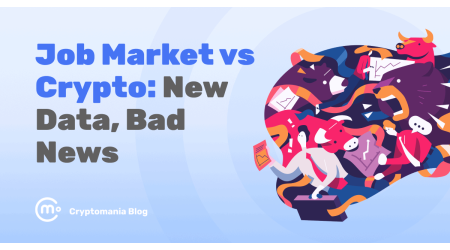TradFi Adopts Crypto: Are Crypto-native Platforms Doomed?
Jane Savitskaya


Are crypto exchanges already past their prime? With regulators now opening the doors for Wall Street giants to trade Bitcoin and Ethereum, the question isn’t about whether TradFi vs DeFi confrontation is going to happen. It’s whether crypto-native platforms can survive the impact.
Traditional finance has history, trust, and regulation on its side. Crypto platforms have innovation, speed, and global reach. But with Nasdaq, NYSE, and CME preparing to step into the spot crypto market, the competition just got real.
So, are Coinbase and Binance the future, or are they about to get outplayed on their own turf? Let’s sort it out.
What is TradFi?
TradFi is short for “traditional finance”. It’s the system we all grew up with: banks, stock exchanges, insurance companies, and regulators.
It’s the money infrastructure that’s been around for centuries, built on trust, oversight, and a mountain of rules.

In TradFi, your savings sit in a bank account, your stocks trade on the NYSE, and your pension fund is managed by someone who answers to regulators. It’s structured, slow to change, and, depending on who you ask, either reassuringly stable or frustratingly outdated.
The key point: TradFi runs on regulation and trust in institutions. You don’t hold your own assets: your bank or broker does. And while that makes it harder for you to “lose everything overnight,” it also means you’re playing inside a tightly controlled system.
TradFi meets crypto: SEC & CFTC greenlight
Crypto exchanges aren’t exactly new — you already know how they work. What’s new is who’s about to join the party. On September 2, the SEC and CFTC announced they’re set to allow spot crypto trading on U.S.-registered exchanges.
Translation: giants like the NYSE, Nasdaq, and CME could soon list Bitcoin, Ethereum, and beyond, right alongside stocks and futures.
That’s a big deal. It means institutions and everyday investors will be able to buy crypto on the same platforms they already use to trade Apple or Tesla. No new apps, no shady signups, no explaining to your accountant what a DEX is. Just log in, click “buy,” and you’re done.
The easier you make something, the more people will do it. And this is the ultimate unlock: crypto on familiar TradFi rails, available 24/7, without the baggage of learning a whole new system.
What looks like a dull regulatory update could end up being the most important step yet toward mass adoption.
TradFi vs DeFi: The real confrontation
With the SEC and CFTC opening the door into the crypto market for Wall Street, the battleground shifts. It’s not just TradFi vs Coinbase anymore — it’s TradFi vs the entire crypto exchange ecosystem, including DeFi players like Uniswap.
For centralized exchanges such as Binance and Coinbase, the threat is obvious. If investors can buy Bitcoin directly on Nasdaq with the same broker they already use for stocks, why bother creating an account somewhere else? Convenience and trust could drain liquidity away from crypto-native platforms fast.
DeFi isn’t immune either. Uniswap and other decentralized exchanges built their appeal on openness and peer-to-peer access. But if mainstream users can get the same tokens on highly regulated, institution-approved rails, the “wild west” narrative starts to lose its charm, especially for those who value safety over experimentation.
The shift sure won’t kill crypto exchanges outright, but it does raise the bar.
To level up the competition, they’ll need to double down on what TradFi can’t easily copy: decentralization, innovation, and global accessibility. Or they risk becoming redundant as TradFi absorbs their core functions into familiar, regulated platforms.
TradFi’s edge over crypto platforms
It’s true that crypto exchanges have had more than their fair share of disasters: *starts counting fingers* Mt. Gox collapsed, FTX imploded. Even Binance is constantly in regulators’ crosshairs. Each failure chips away at public trust and makes it harder for new users to justify moving their money into crypto-native platforms.
The list of red flags is long:
- High-profile collapses that wiped out billions in user funds.
- Hacks and rug pulls draining liquidity and eroding trust.
- Shaky business models built on leverage and unsustainable incentives.
- Regulatory crackdowns that can halt services for days.
- A growing trust gap compared to established financial institutions.
Now layer in TradFi’s entry. If you’re an investor deciding between Coinbase and the NYSE, one comes with a decade of scandals and uncertainty, the other with centuries of regulation and institutional trust. That comparison isn’t flattering for crypto.
Of course, exchanges won’t disappear overnight. But the combination of self-inflicted wounds and external competition explains why some predict a joyless future for crypto-only platforms. But hey! Let’s take a look at the brighter side.
Why TradFi isn’t perfect either
Sure, Wall Street has the trust, regulation, and designer suits. But TradFi isn’t flawless — it just fails in different ways. Bank collapses like Lehman Brothers or SVB proved that “too big to fail” is more marketing slogan than the truth. Hidden fees and opaque structures make it hard for customers to know what they’re actually paying for. And let’s not forget the glacial pace of innovation — your bank app is still worse than a five-year-old fintech startup.
And here’s the part TradFi can’t simply replicate: crypto-native platforms aren’t just trading venues. They’re ecosystems. Beyond buying and selling tokens, they offer:
- Wallets for custody and direct ownership of assets.
- Staking to earn rewards for securing networks.
- Yield farming and liquidity pools that turn idle assets into income streams.
- NFT marketplaces, gaming integrations, and token launches that expand crypto beyond pure finance.
- On-chain governance, where users can actually vote on how platforms evolve.
TradFi exchanges may offer exposure to Bitcoin and Ethereum, but they’re unlikely to roll out DeFi yield farming or DAO voting any time soon. Their playbook is about compliance and familiar products, not running questionable experiments.
And here’s the kicker: The Satoshi paradox deepens. Mass adoption may require crypto to meet TradFi halfway, but the closer it gets to mainstream rails, the further it drifts from decentralization — the very principle crypto was built on.
Are crypto platforms doomed?
So, are Coinbase, Binance, and the rest on borrowed time? Not necessarily, but the landscape is shifting fast. Once TradFi exchanges like Nasdaq and CME start offering Bitcoin and Ethereum spot trading, crypto platforms lose their monopoly on access. For many investors, buying crypto on the same screen where they already trade stocks will feel safer and simpler. That’s TradFi’s edge: trust and convenience.
But the thing is, crypto platforms aren’t just “buy and sell” shops. They’re ecosystems with staking, lending, yield farming, token launches, and governance tools. These are things TradFi isn’t likely to adopt anytime soon because they’re too experimental (and too messy for regulators). The future probably isn’t an either-or scenario.
Instead, we’ll see:
- TradFi handling mass adoption by offering safe, regulated access to major assets.
- Crypto-native platforms driving innovation with DeFi, NFTs, DAOs, and everything too wild for Wall Street.
- A hybrid system where users bounce between the two depending on their appetite for risk, returns, and freedom.
So no, crypto exchanges aren’t doomed. But their role will change. Competing with TradFi means raising standards, building trust, and leaning harder into what makes them unique: decentralization and innovation. The ones that can’t evolve? They’ll be forgotten, absorbed into the very system they tried to replace.
Final thoughts
The dramatic appearance of TradFi in the crypto arena isn’t the end of the story, more like the start of a new chapter.
Wall Street can bring to the table scale, compliance, and trust, but it won’t replace the creativity and openness that made crypto exciting in the first place.
In the end, it’s not TradFi vs crypto. It’s TradFi with crypto. The question is whether platforms like Binance, Coinbase, and Uniswap can evolve fast enough to stay relevant in a market where the old guard just learned a few new tricks.





